I like this idea in general. What I'd like to suggest first though is an additional and more detailed concept as a separate issue which depicts the rationale/business value, public surface area (Class, Methods, Properties, etc.), small code samples, maybe along with a link to a repo fork which would include the work that you already did (probably with way fewer partial classes/code files ;-) ). Something I could put the label api-suggestion on.
Thoughts?





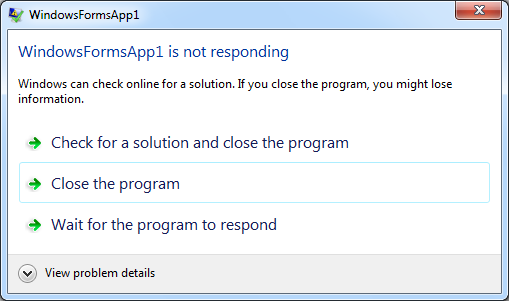
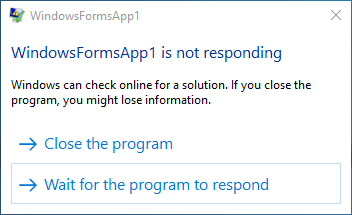
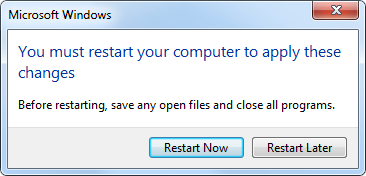
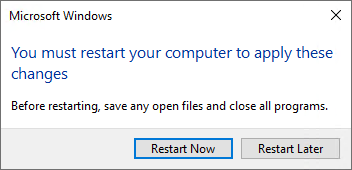
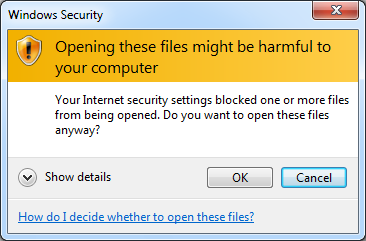
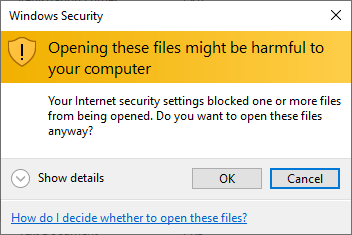
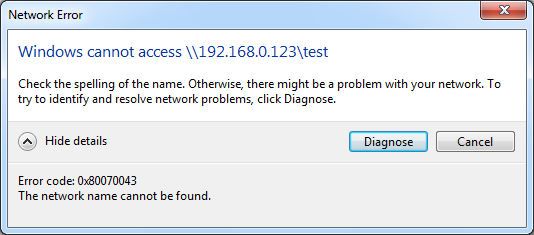
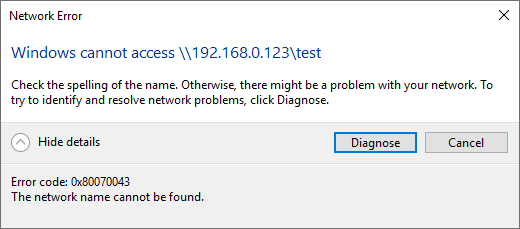
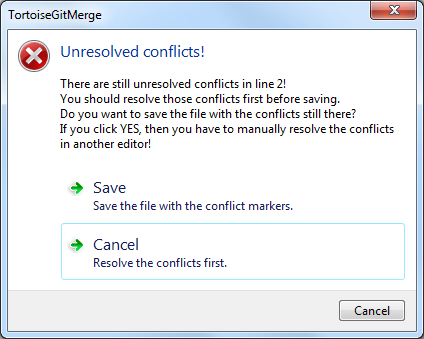
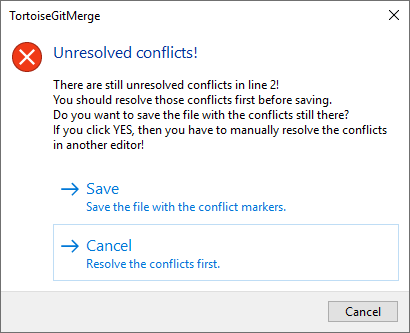
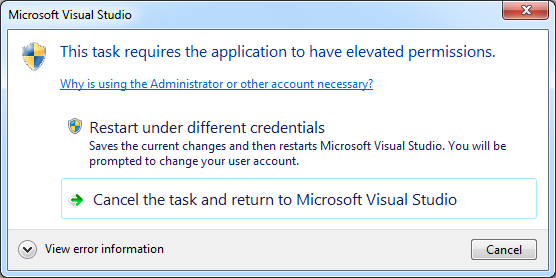
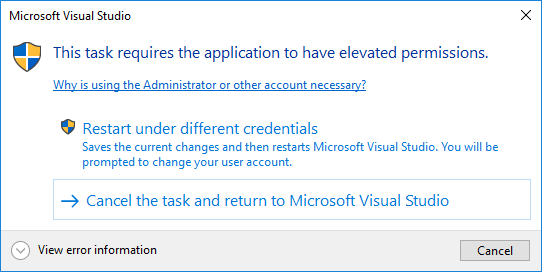
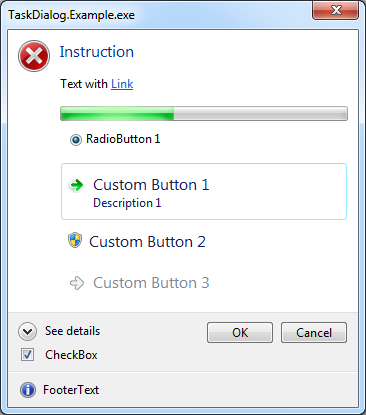
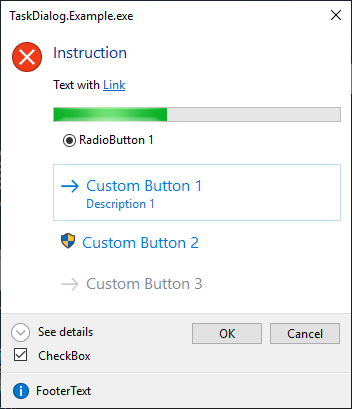
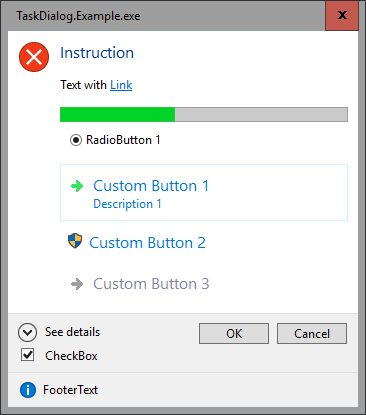
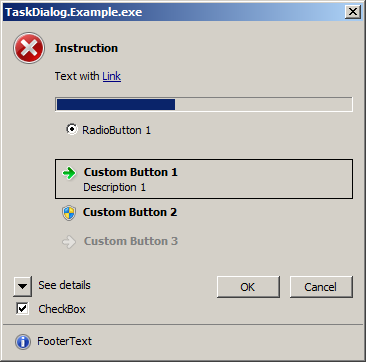
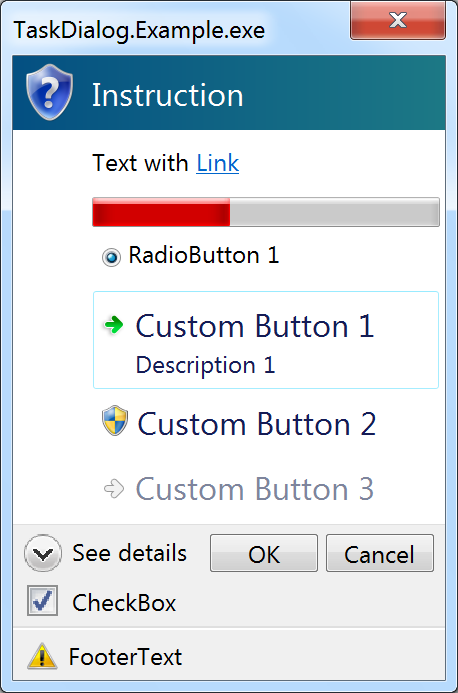
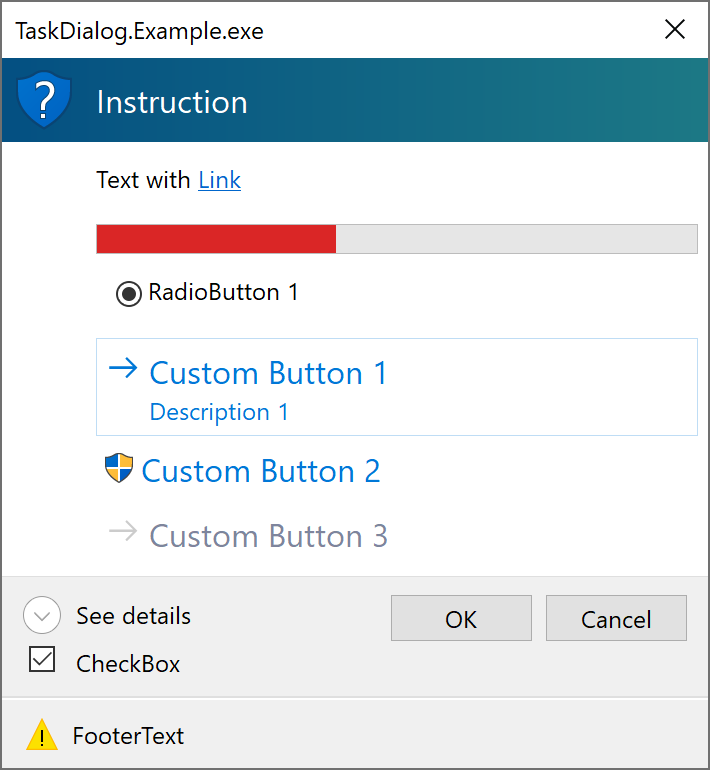







Hi,
On Windows Vista and higher, the Task Dialog is available that provides many more features than a Message Box. While you can show a Message Box in WinForms and WPF, there is no "official" implementation of the Task Dialog yet in .NET WinForms/WPF.
There was an implementation in the Windows API Code Pack 1.1, but it is no longer available/updated, it did not implement all features (like navigation or modifying common/standard buttons), and I believe it had some memory management issues (like not calling
Marshal.DestroyStructure()after callingMarshal.StructureToPtr()in order to free allocated strings for custom/radio buttons) and a few other issues.At my company, we currently use the Task Dialog in a (commercial) WPF application to show a marquee progress bar while an operation (like database backup) is running, and then navigate it to one showing a green header to indicate the operation is finished.
Visual Studio is also using a Task Dialog: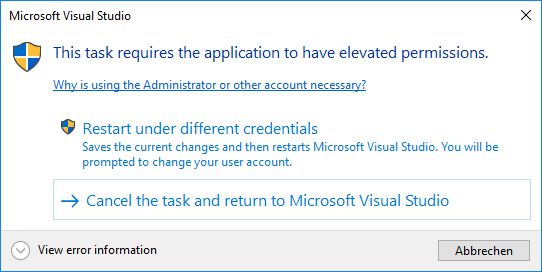
Also, the Windows Design Guidelines (Desktop Apps) for Messages and Dialog Boxes show features of the task dialog.
Do you think a Task Dialog could also be added directly to WinForms/WPF? Thank you!
Edit:
Rationale and Usage
The Windows Task Dialog (which is available since Windows Vista) has a lot of configuration options comparing to a regular Message Box, can show additional controls like a progress bar, and supports event handling. However, it has not yet been integrated officially into WinForms/WPF, so if you wanted to use it, you had to implement the native APIs yourself, or use a 3rd party library.
Implementing the Task Dialog directly in WinForms allows users to directly use the Task Dialog in any new WinForms/WPF .NET Core application, just like a MessageBox. You can then either use the simple static
Show()method (similar to a MessageBox), or you can create an instance of theTaskDialog, configure itsTaskDialogPageand then show it.Features of the proposed Task Dialog:
TaskDialogPage.Navigate(TaskDialogPage)while the dialog is displayedhWnd) through theHandleproperty so that the dialog window can be further manipulated (or used as owner for another window)See also the Task Dialog Demo App for examples.
Show a simple Task Dialog
Dialog similar to the Visual Studio dialog
Show a multi-page dialog that shows current progress, then navigates to a result
See also: Multi-page dialog boxes
Other examples from existing applications
"Save document" dialog from Notepad/Paint/WordPad
Windows 7 Minesweeper Difficulty Selection
Windows Security dialog when trying to access network files
Auto-closing Dialog (closes after 5 seconds)
Proposed API
TODO: Which namespace to use for the types? In the PR I used
System.Windows.Formsfor now.Event Cycle
The events in the proposed API currently have the folowing cycle at runtime (the diagram illustrates navigating the dialog in the
TaskDialogButton.Clickevent):Implementation
The proposed API is implemented with PR #1133.
API Updates
Removed propertyTaskDialogContents.DoNotSetForegroundas it doesn't seem to have an effectTaskDialogControlCollectionandTaskDialogButtonCollectionTaskDialogCustomButtonCollectionandTaskDialogRadioButtonCollectioninherit fromCollectioninstead ofKeyedCollectionTaskDialogButtonstoTaskDialogCommonButtonCollectionResultVerificationFlagChangedfromTaskDialogExpandedByDefaulttoExpanded(TaskDialogExpander) (so its value will be updated when the user clicks the expando button)imageres.dll)TaskDialogextendsSystem.ComponentsModel.Component(and is disposable)Tagproperty toTaskDialogControlTaskDialogCommonButtonnow has a default constructor (like other control classes)MainInstruction->Instruction,Content->Text,ButtonClicked->Click)TaskDialogRadioButtonandTaskDialogVerificationCheckboxhas been aligned with WinForms concepts (propertyChecked, eventCheckedChanged).TaskDialogVerificationCheckboxtoTaskDialogCheckBox(along with properties)TaskDialogProgressBarRangeto be used for theTaskDialogProgressBar.Rangeproperty instead of(int min, int max)for better designer supportTaskDialogContents.DoNotSetForegroundas it is actually working.TaskDialogBooleanStatusEventArgs.TaskDialogProgressBarStateenum valueMarqueeDisabledtoMarqueePausedTaskDialogControlabstractTaskDialogIcon.StoptoErrorTaskDialogProgressBar.Rangeproperty (along with theTaskDialogProgressBarRangestruct) and instead added propertiesMinimumandMaximumdirectly on theTaskDialogProgressBarand also renamed propertyPositiontoValue, to simplify the API and align with the WinForms ProgressBarTaskDialogContents(FooterText,FooterIcon,FooterIconHandle) into their ownTaskDialogFooterclass. The reasoning for this is that a separate dialog area is added for the footer when it is used (as shown in the below image), similar to the expander (and it reduces the number of properties inTaskDialogContents).Also, when you intially don't create a footer when showing the task dialog, you cannot later add one by updating the
FooterTextproperty, similar to theTextproperty of theExpander(which is different from the other text properties likeTaskDialogContents.TextandInstructionthat can be added later).A separate
TaskDialogFooterclass that inherits fromTaskDialogControlcan thus share the behavior withtaskDialogExpanderto throw anInvalidOperationExceptionwhen trying to update itsTextproperty but the control wasn't created because it was initiallynull(orstring.Empty).TaskDialog.ClosingtoClosedandTaskDialogContents.DestroyingtoDestroyed, and added a newTaskDialog.Closingevent that is called directly after aTaskDialogButton.Clickevent if the button would close the dialog, and it allows to cancel the close (similar toForm.FormClosingevent in WinForms) - see this comment (Option B).TaskDialogExpander.ExpandoButtonClickedtoExpandedChangedTaskDialogContentstoTaskDialogPageand propertyTaskDialog.CurrentContentstoTaskDialog.Page. This is because the documentation also talks about "navigating to a new page" - for example see Multi-page dialog boxes.TimerTickevent onTaskDialogPage: This event represents theTDN_TIMERnotification that is called every 200 ms if theTDF_CALLBACK_TIMERflag was set in the task dialog config. The previous implementation specified the flag if the event handler has been set (like the implementation in the Windows API Code Pack did), but this means you could not add an event handler to theTimerTickevent after the dialog is displayed/navigated. Also, the interval of200is fixed (and a user might get the impression that the dialog can only be updated every 200 ms, which is not the case). Instead, the user can use one of the already existing UI timer implementations likeSystem.Windows.Forms.Timer. Both the Task Dialog timer and the WinForms Timer use a Windows timer (WM_TIMERmessages), so using the WinForms timer should have the same behavior as the TaskDialog timer but with more flexibility.StartupLocationfromTaskDialogPagetoTaskDialogbecause it only has an effect when showing the dialog (but not when navigating it) and therefore isn't related to the page (which represents the contents of the dialog).Added eventsEdit: Removed these again because of an unresolved issue when closing the dialog.TaskDialog.ActivatedandTaskDialog.Deactivated.TaskDialog.Shown(similar toForm.Shown).TaskDialogCommonButtontoTaskDialogStandardButton(along with collections and property names).TaskDialogPage.DoNotSetForegroundtoTaskDialogbecause it only has an effect when showing the dialog, but not when navigating it.Icon+IconHandleonTaskDialogPageandTaskDialogFooterinto a singleIconproperty use subclasses to differentiate between icon types (see https://github.com/dotnet/winforms/issues/146#issuecomment-467032370). This should avoid confusion about having two mutually exclusive properties (and it allows to initially not showing an icon but then updating it to one using a handle (without using navigation)). Additionally, it will allow us in the future to add an additional icon type that represents integer/string resource icons (e.g. fromimageres.dllor the application's executable), which could also be shown using a colored bar (which is not possible when using a handle).TaskDialogPage.CommandLinkModetoCustomButtonStyle(along with the enum).TaskDialogno longer inherits fromSystem.ComponentModel.Componentwhich was used for trying to implement designer support, but that would require additional work. It be revisited for a future version.TaskDialogPage.HelptoHelpRequest(and methodOnHelptoOnHelpRequest) as discussed in #1133.TaskDialog.DoNotSetForegroundtoTaskDialog.SetToForeground(the default value is still false), as per the feedback in #1133.TaskDialog.ShowtoShowDialog.TaskDialogPage.InstructiontoMainInstruction(same with parameter names for the staticTaskDialog.Showmethods).TaskDialogPage.TitletoCaption(same with parameter names for the staticTaskDialog.Showmethods).TaskDialogButtonClickedEventArgsand instead added boolean propertyTaskDialogButton.ShouldCloseDialogthat allows to specify whether clicking the button should close the task dialog.TaskDialogStandardIconandTaskDialogIconHandle, and instead added static fields onTaskDialogIconfor the standard icons, and added a constructor taking an icon or icon handle.intindexer toTaskDialogStandardButtonCollectionto avoid an overload resolution in the C# compiler for expressions likepage.StandardButtons[0]. See https://github.com/dotnet/winforms/pull/1133#issuecomment-557483834stringtoTaskDialogFooter.TaskDialogExpander.ExpandFooterAreawithPosition(using enum typeTaskDialogExpanderPosition).TaskDialogPage.BoundDialogandTaskDialogControl.BoundPage, so that it is possible e.g. to access the currentTaskDialoginstance in a button click handler. See discussion here.SecurityShield,SecurityShieldBlueBar,SecurityShieldGrayBar,SecurityWarningYellowBar,SecurityErrorRedBar,SecuritySuccessGreenBartoShield,ShieldBlueBar,ShieldGrayBar,ShieldWarningYellowBar,ShieldErrorRedBar,ShieldSuccessGreenBar; as the term "security" would imply that such icons will/must be used for security purposes.TaskDialogPage.CanBeMinimizedtoAllowMinimize.TaskDialogButton.ShouldCloseDialogtoAllowCloseDialog.TaskDialogStandardButtonandTaskDialogCustomButtonconstructors and to theTaskDialogStandardButtonCollection.AddandTaskDialogCustomButtonCollection.Addmethods.TaskDialogButton.ClickfromEventHandler<EventArgs>toEventHandler.StartupLocationto a parameter ofShowDialog()- see kpreisser/winforms#16TaskDialogIconfrom aBitmap- see kpreisser/winforms#15TaskDialogPage.MainInstructiontoHeading- see kpreisser/winforms#6TaskDialogFooter(and corresponding properties) toTaskDialogFootnote- see kpreisser/winforms#8TaskDialogStartupLocation.CenterParenttoCenterOwnerTaskDialogCheckBox.Focus()TaskDialogButton.ElevationRequiredtoShowShieldIconTaskDialogCheckBox(and corresponding properties) to `TaskDialogVerificationCheckBox´ - see kpreisser/winforms#18TaskDialogPage.WidthPossible API TODOs
TaskDialogProgressBarStatetoTaskDialogProgressBarStyleTagonTaskDialogPage(which is already present onTaskDialogControl)ShowDialog()should behave. Currently, it either shows the dialog modal (when specifying an owner) or non-modal, but in both cases the method does not return until the dialog has closed (similar toForm.ShowDialog()), which is the behavior of the nativeTaskDialogIndirectfunction.This is the same as with
MessageBox.Show(); however, theMessageBoxautomatically uses the current foreground window as owner when you don't specify the owner. For the Task Dialog however, it definitely should be possible to show it non-modal.Note that this means you can show multiple non-modal dialogs at once, but each open dialog will add a
TaskDialog.Show()entry in the call stack.API Usage Notes
InvalidOperationException(this was also the behavior of the task dialog implementation in the Windows API Code Pack).For example, radio buttons cannot be unselected while the dialog is shown (but they can be selected). This means that assigning
falseto theTaskDialogRadioButton.Checkedproperty (while the radio button is shown in a task dialog) will throw.TaskDialogButtonCollectiondoes not necessarily reflect the order in which the task dialog actually displays the buttons (since common buttons are specified by flags in theTASKDIALOGCONFIGstructure, whereas custom buttons are stored in an array). The native task dialog displays buttons from the collection in the following order:OKYesNoAbortRetryCancelIgnoreTryAgainContinueCloseHelpTaskDialog.ShowDialog()can return aTaskDialogButtonwhich was not added to the dialog in the following cases (which results from the native task dialog implementation):TaskDialogButton.OKbutton is returned when the user clicks it.Close()method, orTaskDialogPage.AllowCancelhas been set and the dialog is closed by the user by pressing ESC or Alt+F4 or clicking the X button in the title bar. In these cases theTaskDialogButton.Cancelbutton will be returned. This can also happen when a non-modal task dialog is shown but the main window of the app is closed, in which case the task dialog is also closed and returns aCancelresult.imageres.dll), by initially specifying one of theShield...Baricons, and when the dialog is shown, update it to a different icon:imageres.dll) (by specifying thehInstancefield of the nativeTASKDIALOGCONFIGstruct), which would then allow you to show a custom icon with a colored bar.